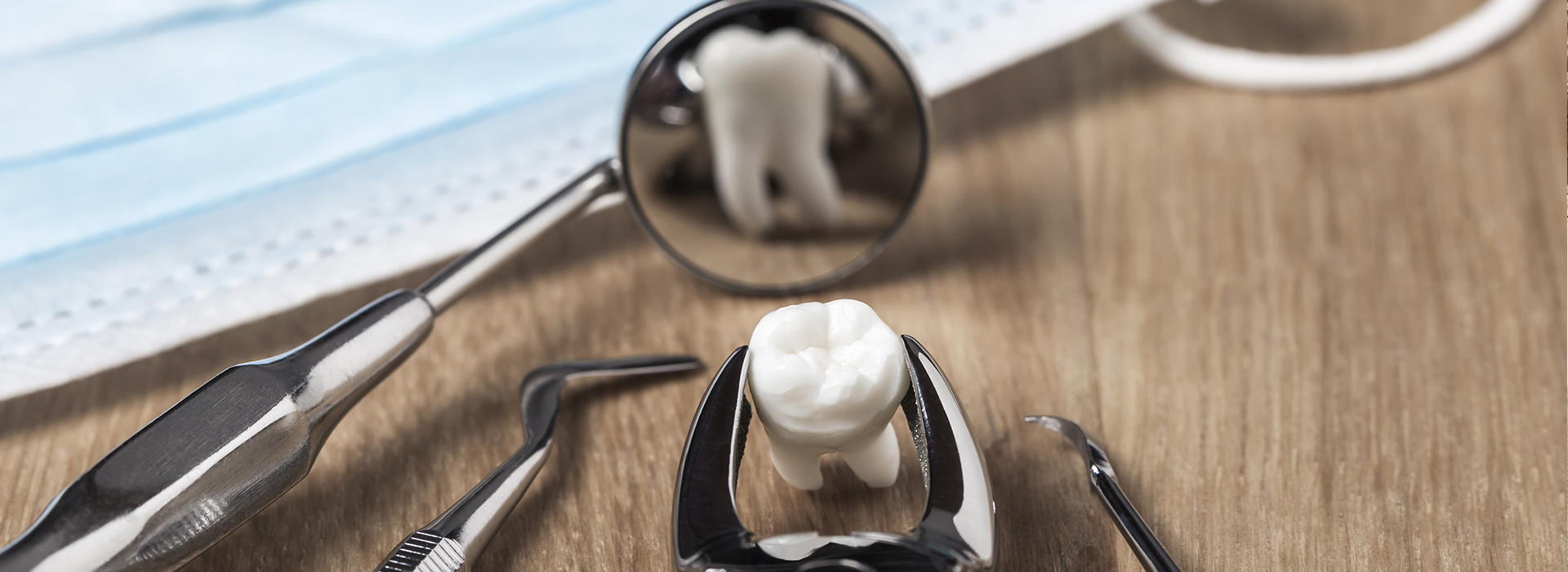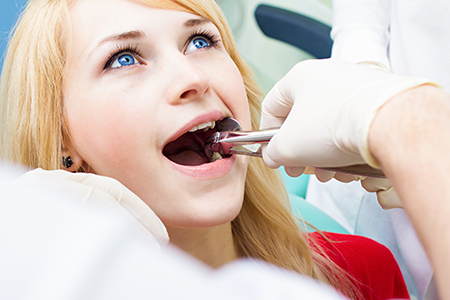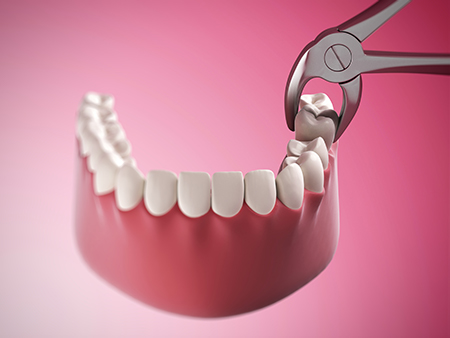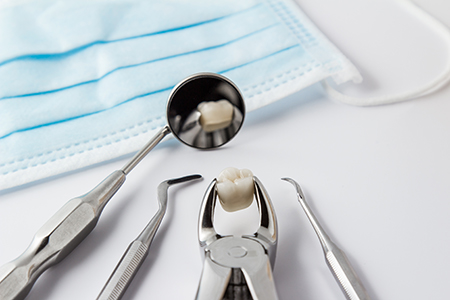

Having a tooth removed can feel intimidating, but knowing the steps and reasons behind the decision makes the process far more manageable. At our Richmond Hill office we prioritize clear explanations, compassionate care, and pain control so patients can face extractions with confidence rather than fear. Our team works closely with each patient to tailor treatment to their needs and to preserve oral health whenever possible.
Extractions are recommended only after careful evaluation and when preservation of the tooth is not a safe or realistic option. Removing a tooth can prevent the spread of infection, stop ongoing pain, and protect the alignment and function of the rest of the mouth. We focus on doing the procedure with precision and minimizing disruption to surrounding tissues.
Modern dentistry offers effective ways to manage anxiety and discomfort, including local anesthetics and sedation options when appropriate. Before any procedure begins, we review your medical history, current medications, and any special considerations to design a treatment plan that promotes a smooth procedure and a predictable recovery.
There are several clinical situations that make extraction the most responsible choice for long-term oral health. Rather than a one-size-fits-all approach, we evaluate the tooth’s condition, the supporting bone and gums, and how the tooth fits into the overall bite. This assessment guides whether a tooth can be restored or is better removed to protect your well-being.
Removal may also be part of coordinated treatment plans — for example, to allow an erupting permanent tooth to take its place, to prepare for orthodontic work, or to make way for prosthetic replacements that ultimately improve function and comfort. In every case, the goal is to preserve or restore the health of the entire mouth.
We will always explain alternatives when they exist and discuss next steps for tooth replacement if indicated. Decisions are made with your long-term oral health in mind and with consideration for your comfort and recovery.
Primary (baby) teeth that won’t fall out or are severely compromised
Normally, baby teeth loosen and give way as permanent teeth push into place. Occasionally a primary tooth remains firmly attached due to root abnormalities or fusion to the jawbone. When a retained baby tooth risks blocking normal development or causing alignment problems, careful removal can protect your child’s smile and future orthodontic needs.
Permanently damaged teeth that cannot be restored
When decay or structural damage has destroyed most of a tooth’s usable structure, restorative procedures like fillings or crowns may no longer be possible. In such situations, extraction removes the source of infection and pain and prevents complications that could affect neighboring teeth and tissues.
Severe cracks or fractures that compromise the root
Teeth can fracture in many ways. Superficial chips are often repairable, but deep vertical fractures that extend into the root or split the tooth can make successful salvage impossible. Extracting a severely fractured tooth protects the surrounding structures and prevents persistent discomfort or infection.
Advanced periodontal (gum) disease affecting tooth support
When periodontal disease progresses, it erodes the bone and soft tissues that anchor teeth. In advanced cases, teeth can become loose, painful, or prone to infection. Extraction may be the most predictable way to restore oral health and create a stable foundation for future restorative options.
Wisdom teeth that are impacted, poorly positioned, or decayed
Third molars are the last to erupt and often lack room to emerge properly. Impacted or partially erupted wisdom teeth can damage adjacent teeth, increase infection risk, and cause crowding. Early evaluation and timely removal when indicated can prevent more complex problems later on.
Extractions as part of orthodontic or restorative planning
In some treatment plans, removing one or more teeth creates the necessary space to align the bite or to accommodate restorations comfortably and predictably. These decisions are made in partnership with you and your orthodontist or restorative specialist to achieve a healthy, functional outcome.

Every extraction begins with a thorough clinical exam and imaging as needed to understand root shape, bone levels, and proximity to important anatomical structures. Digital radiographs give us the clarity required to plan the most straightforward, safe approach. We review findings with you and answer any questions before treatment proceeds.
On the day of the procedure, local anesthesia is used to numb the area completely. For patients who prefer additional relief from anxiety, we discuss sedation options in advance and explain what to expect during recovery. Our priority is to keep you comfortable while maintaining precise control during the extraction.
Extractions usually fall into two categories: simple and surgical. Simple extractions are performed when the tooth is fully visible and the root anatomy is straightforward. Surgical extractions are reserved for teeth that are broken below the gum line, ankylosed (fused to bone), or impacted. Surgical cases may require minor incisions and careful removal of small amounts of bone to access and extract the tooth.
In a simple extraction, the dentist numbs the area and then uses gentle, controlled movements to loosen the tooth and remove it with forceps. The process is designed to minimize trauma to the surrounding gum and bone. Most simple extractions are completed quickly, and patients can go home the same day with clear aftercare instructions.
Surgical extractions are more involved and may be performed by an oral surgeon when specialized techniques are required. The procedure can include a small incision in the gum and removal of bone around the tooth to allow safe extraction. Appropriate anesthesia and, when indicated, sedation ensure patient comfort throughout. Afterward, we provide specific instructions and follow-up plans to support healing.

Recovery after an extraction focuses on controlling bleeding, managing swelling, and protecting the developing blood clot at the site. We provide clear, individualized post-operative directions that cover activity restrictions, medication guidance, and nutrition recommendations to promote the fastest, safest healing.
It’s normal to experience mild discomfort and some swelling during the first 48–72 hours. Cold compresses, rest, and prescribed or recommended over-the-counter pain relievers usually control symptoms effectively. Follow-up appointments are scheduled when necessary to remove sutures or to check on healing progress.
If you have complex medical conditions or take medications that affect bleeding or healing, we coordinate with your physician as needed and tailor your aftercare plan. Prompt communication with our office about any unexpected signs helps us address issues early and keep recovery on track.
Keeping pressure on the socket
After the extraction, a gauze pad will be placed over the site. Biting gently on the pad for the first hour helps the clot to form. Replace the gauze as instructed and continue to apply pressure if light bleeding persists. A little oozing is common for 24 hours, but if bleeding is heavy or prolonged, contact our office immediately.
Protect the numb area
Until the local anesthetic fully wears off, avoid chewing or touching the area with your tongue, lips, or fingers to prevent accidental injury.
Follow medication instructions
If antibiotics are prescribed, take the entire course as directed. For pain control, take recommended analgesics before the anesthetic wears off to stay ahead of discomfort and follow dosing guidance carefully for any prescription medications.
Avoid disrupting the clot
Do not rinse vigorously, spit forcefully, or use a straw for the first 24–48 hours. These actions can dislodge the clot and delay healing.
Use ice to manage swelling
Apply a cold pack to the affected cheek in short intervals (about 10 minutes on, 10 minutes off) during the first day to reduce swelling.
Avoid tobacco and vaping
Smoking impairs clot stability and tissue repair. Refrain from smoking or using tobacco products for at least one week after extraction to support predictable healing.
Choose gentle foods and stay hydrated
Stick to soft, cool, or room-temperature foods for the first few days and avoid hot liquids. Hydration supports recovery, but avoid carbonated or alcoholic beverages initially.
Maintain careful oral hygiene
Keep your mouth clean while protecting the extraction site. Brush other teeth normally but be gentle near the area. A mild saltwater rinse can be introduced after 24 hours to soothe tissues—use light movements and do not spit forcefully.
Attend scheduled follow-up visits
Return for any recommended post-operative checks so we can confirm that healing is progressing and address any concerns quickly.
If you notice persistent bleeding, increasing pain, swelling that worsens rather than improves, or an unusual taste or odor, please contact our office so we can evaluate and manage the issue promptly.

Choosing where to have an extraction performed is an important decision. Our team combines experience, up-to-date techniques, and a patient-centered approach to ensure treatments are executed safely and comfortably. We emphasize careful planning, precise technique, and clear follow-up so every patient understands their options for healing and replacement if needed.
When tooth replacement is part of the conversation, we explain the restorative pathways—such as fixed bridges, dentures, or implant-supported solutions—and how each option affects function, appearance, and long-term oral health. The practice works with you to identify the most appropriate next steps following extraction.
In summary, extractions are performed to protect and restore oral health when preservation is not feasible. If you have questions about whether an extraction is recommended, what the procedure involves, or what comes next, please contact us for more information and personalized guidance.
The most common reasons for tooth loss include advanced periodontal disease, extensive tooth decay, and facial trauma. According to statistics, gum disease is responsible for close to 70% of tooth loss in adults. Although less frequent than the preceding three reasons, it should also be noted that specific diseases, drugs, smoking, and poor nutrition contribute to the risk of tooth loss.
The Centers for Disease Control and Prevention report that in the United States, an average of 12 teeth (including the wisdom teeth) are lost by the age of 50. Also, 26% of adults between 65 and 74 years of age have lost all their teeth.
Every patient and every situation is different. However, when a tooth and the surrounding tissues are numbed with a local anesthetic, you should only expect to feel a bit of pressure, but no pain as the tooth is being loosened from the surrounding tissues and extracted. For patients who are apprehensive and for some surgical extractions, our office will discuss our options in dental sedation to provide further relaxation and reduce any sense of discomfort.
While it's normal to feel some tenderness and swelling following an extraction, the degree of these sensations can vary. It mostly depends on the complexity of the extraction and the body's response to the procedure. We'll recommend or prescribe the appropriate pain medication to help ensure your comfort and give you specific instructions for maximum effectiveness and safety.
Typically, the recovery period following a simple extraction is shorter than a surgical extraction. However, a patient's overall health, habits, the size and location of the tooth, and other variables can influence recovery and healing. To speed up the recovery and avoid any complications, patients must follow the given at-home instructions diligently. We'll carefully review what to expect following your procedure and go over your post-op instructions.
Smoking interferes with blood clot formation, which is an essential first step in the healing process. Blood clot formation not only provides a protective layer to cover the underlying exposed bone and nerve endings, but it also supports the growth of new tissue. Cigarette smoke also contains chemical toxins that can disrupt the healing process and lead to problems such as continued inflammation, infection, or dry socket.
In a very small percentage of cases, a condition known as dry socket can develop in the aftermath of a dental extraction. This painful condition can arise when the blood clot in the extraction site doesn't form properly or gets dislodged. With dry socket, you may experience throbbing pain and symptoms such as bad breath and an unpleasant taste in your mouth. As skilled providers of care, our office will provide immediate treatment to alleviate your discomfort and promote healing.
The last teeth in your mouth to develop, wisdom teeth often do not have enough room to fully erupt or may be positioned in the wrong direction. These issues can affect your dental health as well as overall wellbeing. While some individuals never develop all their wisdom teeth, and a few have sufficient space for them, there are many people with partially or fully impacted third molars. Our office will monitor the development, position, and health of your wisdom teeth and will advise you if and when extractions are indicated.
After a tooth is removed, bone-grafting material is sometimes placed in the socket to promote healing and encourage new bone development. This procedure is often performed to support the eventual and successful placement of a dental implant.
At the office of Liberty Dental Care PC by Park One Dental, we strive to make dental care affordable and accessible. Depending on the type or complexity of the extraction and other variables, the cost of the procedure can vary. Based on our diagnostic findings, our office will inform you of the healthiest choices in care, explain the fees, discuss insurance coverage, and explain your payment options.
Many dental plans offer some level of coverage for tooth extractions. We'll advise you if your plan covers the full cost of the procedure and if there is any out-of-pocket expense. Our business office will work with you to maximize your insurance benefits as much as possible while helping you minimize any out-of-pocket expenses.
A tooth extraction is a dental procedure in which a tooth is removed from its socket in the jaw. Extractions are performed to protect overall oral health when a tooth cannot be saved by restorative treatments or when it poses a risk to surrounding teeth and tissues. Common scenarios include severe decay, irreparable fracture, or a tooth that is preventing proper healing of the mouth.
Your dentist will evaluate your individual situation, review diagnostic images, and discuss alternatives such as restorations, root canal therapy, or monitoring when appropriate. When extraction is the safest or most predictable option, the procedure is planned to minimize discomfort and preserve the adjacent structures. Decisions about extraction are based on clinical findings, radiographs, and the goal of maintaining long-term oral health.
There are several common reasons for recommending extraction, including a baby tooth that is overretained or ankylosed, a permanent tooth with extensive decay that cannot be restored, and a tooth that is fractured beyond repair. Advanced periodontal disease that has compromised the tooth's supporting bone and tissues can also make extraction necessary to prevent ongoing infection and damage to neighboring teeth. Impacted or poorly positioned wisdom teeth often require removal when they threaten adjacent teeth or the surrounding tissues.
Extractions may also be part of orthodontic treatment to create space and achieve proper alignment when the jaws are too small for all the permanent teeth. In some cases, a tooth is removed to improve the success of other dental treatments or to eliminate a recurring source of infection. Your dentist will explain the specific reason for extraction in your case and how it supports your overall treatment plan.
Preparation begins with a thorough review of your medical and dental history, including any medications you take and existing health conditions. Be sure to inform the dental team about bleeding disorders, heart conditions, diabetes, or medications such as blood thinners, since these factors can affect treatment planning and may require coordination with your physician. Your dentist will provide preoperative instructions tailored to the type of extraction and any sedation you will receive.
For patients receiving sedation, you may be asked to fast for a specified period and arrange for a responsible adult to drive you home after the procedure. Wear comfortable clothing and avoid smoking before surgery, as nicotine can interfere with anesthesia and healing. If you have questions about how to prepare, the dental team at Liberty Dental Care PC by Park One Dental will review all directives and address concerns during your consultation.
A simple extraction is performed on a tooth that is visible in the mouth and has a straightforward root anatomy, allowing the dentist to loosen the tooth and remove it using instruments and forceps after local anesthesia. These procedures are typically quicker and may be appropriate for teeth that are mobile or otherwise accessible. Simple extractions are often performed in the general dental office setting with local anesthesia and optional sedation for comfort.
Surgical extractions are indicated when a tooth is broken at the gum line, ankylosed, impacted, or has complex root morphology that prevents simple removal. Surgical procedures commonly involve making a small incision in the gum, removing a portion of bone, or sectioning the tooth to facilitate removal, and they may be performed by an oral surgeon. Your dentist will recommend the appropriate approach and, when necessary, refer you to a specialist to ensure safe and predictable care.
Local anesthesia is used routinely to numb the tooth and surrounding tissues so the extraction is performed without pain during the procedure. For patients with anxiety or for more complex extractions, additional options such as nitrous oxide (laughing gas), oral sedation, or intravenous sedation may be available to promote relaxation and comfort. The choice of sedation depends on the complexity of the extraction, your medical history, and your comfort level.
Pain management after the procedure may include over-the-counter analgesics or prescription medications when appropriate, and your dentist will advise on timing and dosing to control discomfort. Following recommended post-op instructions and taking medications as directed helps reduce pain and inflammation and supports an uncomplicated recovery. Any concerns about anesthesia or pain control should be discussed during your preoperative consultation so the team can tailor the plan to your needs.
Immediately after an extraction you can expect some bleeding, swelling, and numbness in the area while the local anesthetic wears off. Your dentist will place gauze over the extraction site and ask you to bite down to help form a clot and control bleeding; this clot is a key part of the normal healing process. Plan to rest for the remainder of the day and avoid strenuous activity that can increase blood flow to the area and prolong bleeding.
Swelling typically peaks within 24 to 48 hours and can be managed with intermittent ice application during the first day and by keeping your head elevated. Mild to moderate discomfort is common and generally well controlled with recommended pain medications and by following post-operative instructions. If symptoms worsen or you experience unusual signs such as persistent heavy bleeding or severe increasing pain, contact the dental office for guidance.
To promote healing, maintain firm but gentle pressure with gauze as directed and avoid actions that could dislodge the developing blood clot, such as rinsing vigorously, spitting, using a straw, or smoking for at least the first 24 to 72 hours. Keep physical activity to a minimum and follow dietary recommendations by eating soft, nutritious foods and avoiding hot or spicy items during the initial healing phase. Applying ice intermittently during the first 24 hours and then switching to warm compresses as swelling resolves can help manage inflammation.
Practice cautious oral hygiene by brushing gently and avoiding direct trauma to the extraction site, and begin gentle saltwater rinses only when advised by your dentist to reduce the risk of infection. Take prescribed antibiotics and pain medications exactly as directed and attend any scheduled follow-up appointments to monitor healing. Adhering to these instructions supports clot stability, reduces the chance of complications, and helps tissues regenerate properly.
Although most extractions heal without incident, it is important to watch for warning signs of complications such as persistent heavy bleeding, increasing or severe pain, fever, or swelling that worsens after the first 48 hours. A foul taste in the mouth or unusual drainage from the extraction site can indicate infection and should be evaluated promptly. Numbness that does not improve after the anesthetic wears off may indicate nerve involvement and requires timely assessment.
Another potential complication is dry socket, a painful condition that can occur if the blood clot is dislodged and the bone becomes exposed; symptoms include an intense, throbbing pain that may radiate to the ear and an unpleasant odor. If you experience any of these signs or have concerns about your recovery, contact the dental office so the team can evaluate you and provide appropriate treatment or pain relief measures.
Tooth replacement options include removable dentures, fixed dental bridges, and dental implants, and the timing for replacement depends on the condition of the extraction site and your overall treatment goals. In some cases, immediate replacement is possible, while in others it is best to allow the socket to heal and for bone remodeling to occur before placing a permanent restoration. Your dentist will assess bone volume, gum health, and the health of adjacent teeth to determine the optimal timing and method.
Dental implants are often the most durable and natural-feeling option because they replace both the tooth and its root, but they require adequate bone and a comprehensive treatment plan. Bridges and dentures provide effective alternatives when implants are not indicated or when a different approach better meets a patient's needs. A consultation will review the pros and cons of each option and outline the sequence of care tailored to your oral health and long-term function.
Choosing a practice for extractions should be based on experience, comprehensive care, and patient comfort, and Liberty Dental Care PC by Park One Dental combines these elements to deliver predictable outcomes. The team uses modern diagnostic tools and precise techniques to plan and perform extractions while prioritizing safety and minimizing discomfort. When necessary, the practice coordinates with oral surgery specialists to ensure complex cases receive the appropriate level of care.
Patients benefit from a clear explanation of treatment options, individualized pre-surgical and post-surgical instructions, and attentive follow-up to monitor healing and discuss tooth replacement when indicated. The goal is to preserve oral health, restore function, and support a smooth recovery through evidence-based protocols and compassionate care. If you have questions about extraction planning or what to expect, the office will review the details and create a personalized plan that meets your needs.
Liberty Dental Care PC by Park One Dental
112-10 Liberty Avenue, Richmond Hill, NY 11419Park One Dental
1601 Jericho Turnpike, New Hyde Park, NY 11040 (516) 354-0033